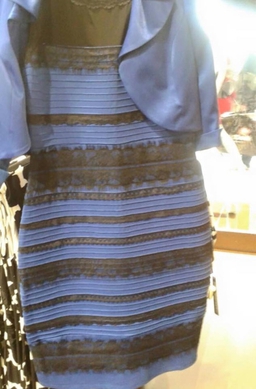
In 2015 social media was rocked with the discovery of The Dress – a seemingly straightforward photo of a wedding dress that defied our basic senses. To some, the dress was blue and black, no mystery there. But to others, it appeared white and gold. And it was not just a trick of a computer monitor, if two people in the same room looked at the same photo, they might see two entirely different colour designs. How could this be?
The reason, scientists believe, is down to how our brain interprets colour. Rather than simply converting light waves, our brains also must adjust to light levels, and that can have an impact on what colours we see. Most of the time we all adjust to those light levels in the same way, but in this case it split people into two camps. Why the split happened is still unclear. But that’s another story.
If we can sometimes literally see different colours, then it raises fascinating questions about how different our point-of-views really can be. What is a ‘fact’ and what is an ‘opinion’ becomes messy. The dress is a unique and extreme example, but we often encounter people with views or opinions that simply don’t add up to how we see the world. We explain, calmly and rationally, what is an obvious and irrefutable fact – climate change is man made, wearing a mask will stop the spread of Covid, I do the washing up more often than you do – but we’re faced with baffling disagreement. At times like these we have no choice but to assume the other person must be mistaken, they have simply misunderstood the situation, or they are deliberately misleading us for some malignant reason. Our only option is to reiterate our position again, more forcefully and with more detail, and hope they get it. But what if the difference between a fact and an opinion were not so clear cut after all, as The Dress suggests?
At Caja, we understand that influencing behaviour goes beyond just stating and restating information. It doesn’t matter how many times you try and tell someone ‘the dress is blue!’, or go into great detail about why it must be blue, they will disagree with you, because they genuinely see something different. Instead, it requires exploration and curiosity into the mindset of the other person. What ‘colours’ are they seeing? Sometimes this can be very counter-intuitive and we find ourselves producing messaging and design concepts that seem to go against our common sense; but if you’re seeing white and gold, having someone validate that and work with you can be very impactful.
Caja have run numerous focus groups with a variety of communities, including South Asian women, Gypsy, Roma and Traveller communities and people with learning disabilities. In each case a unique view of the world is revealed that has a big impact on how information (such as healthcare guidance) is received. For guidance and messaging to be effective, therefore, it has to be adjusted to fit this whole different worldview – cultural or social taboos around cancer that need to be addressed, negative framing being more effective than positive framing (which isn’t normally the case) or certain colours eliciting surprising emotional responses. Only by overcoming our own assumptions, and taking careful note of the perception of others, can we break down barriers and bridge gaps between the intention and reception of the message.
At Caja we work with clients to apply Behavioural Science to a range of real world problems, including increasing customer engagement, promoting digital channel shift and service improvement. Get in touch if you would like to find out more.




